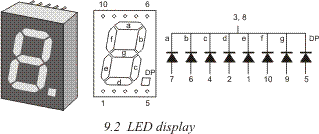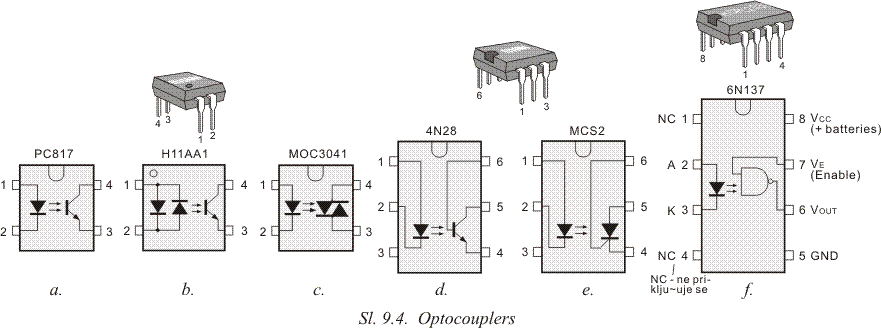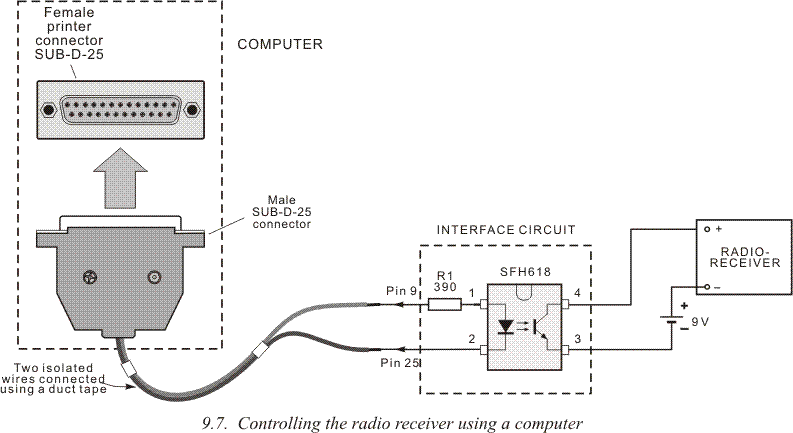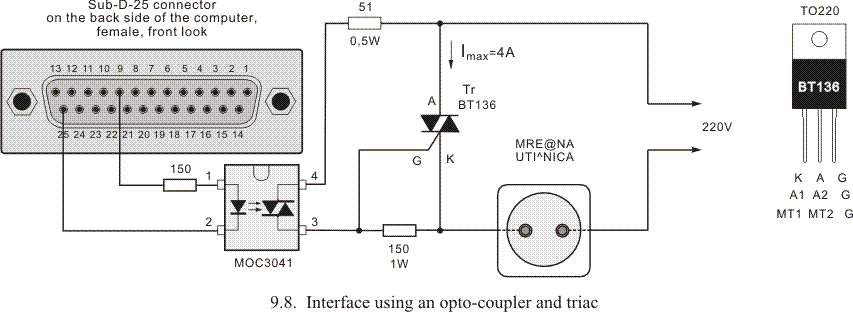|
9.
Opto-electronic components
Optoelectronic components (or as
often referred to photo-electronic components), are electronic
components which produce light or react to it. Some components among
them are LEDs (Light Emitting Diodes), photo transistors, photo diodes,
photo resistors (or LDR – Light Dependant Resistors), different visual
indicators, light emitters and detectors, optocouplers, etc. Many of
those components can be recognized easily recognized because of the
“window” on the component's case which is used to pass the light.
Sometimes, instead of a window, there is a small lens, which directs
light to some predestined location inside of the component. Some of the
most important optoelectronic components are shown on photo 9.1.

9.1 Photo-electronic components
We already mentioned the most frequently used component of them – the
LED. Basic role of a LED in circuits is a visual indicator of, for
example, state of the device (on/off), but is not rare in other
indicator appliances, voltage stabilizers, etc. There is an abundance
of colors, shapes and sizes to choose from, but most frequent ones are
red, green and yellow. Because of the different and more complicated
manufacturing process, blue ones cost a bit more than other ones. There
are square, housed, SMD, angled, ultra bright, multicolored and many
other kinds, but they all have the same principles of use.
 Another
application of LEDs is a LED display. One display is on 9.2. It is, as
shown, facilitated out of 8 diodes marked with an a,b,c,d,e,f,g and DP
(DP being the Decimal Point). These devices come in two possible
flavors – with a common cathode (as this display), or with a common
anode. In both cases it is necessary to connect protection resistors to
to all diodes (which is the same as when working with ordinary LEDs). Another
application of LEDs is a LED display. One display is on 9.2. It is, as
shown, facilitated out of 8 diodes marked with an a,b,c,d,e,f,g and DP
(DP being the Decimal Point). These devices come in two possible
flavors – with a common cathode (as this display), or with a common
anode. In both cases it is necessary to connect protection resistors to
to all diodes (which is the same as when working with ordinary LEDs).
Photo diodes are similar to other, ordinary, diodes internally. One
main difference is in that that photo diode has an exposed surface to
for light to fall onto. These diodes are acting as high value resistor
while in dark. It's resistance lowers as light gains in intensity. In
their behavior they are similar to photo resistors, apart from that as
with all diodes polarity of the component must be appropriately
positioned.

Emitting diodes are special kind of photo-diodes. One of them is the
LED, and some of them include infra-red or ultra-violet emitting for
different wireless communication purposes. Most common area of
application of IR-LEDs (Infra Red) are remote controllers for TVs and
other devices.
Photo diodes are usually housed in round metallic or
square plastic cases with a glass window or a lens which focuses the
incoming light.
Photo-transistor's internal parts are similar to internals of a regular
transistor. One main difference between them is the glass window which
allows light to reach the crystal plate which holds all transistor's
parts. With changes of light intensity, resistance between base and the
collector varies, and this influences variations of the collector
current. In this component light has the same role as voltage over base
of the regular transistor. When intensity rises, current through the
transistor rises as well, and other way round, if intensity fades,
current fades.
Photo electronic components are manufactured in an array of different
case shapes and sizes. Several of them, together with their schematics
symbols are displayed on 9.3.
One special group of photo-electronic components are the optocouplers.
These are special integrated circuits facilitated out of an IR photo
diode, and some component which is sensitive to light (photo
transistor, photo thyristor). Diode is called an emitter, and
“receiving” end is called the detector. This means that the only
connection between the emitter and detector is through a ray of light.
This is an important property of optocouplers, since it allows two
different parts of the circuit which operate on different supply
voltages to connect to each other without actually conducting
electricity, which means that one part could operate on 9V and other on
5V without fear of burning the sensitive lower voltage components.

There are several optocouplers and their cases on 9.4.
Photo transistors on 9.4a are connected to other components in the same
manner as ordinary transistors. Control of current which passes through
it is done by light falling onto it.
Voltage to the diode on 9.4a can be variable in time, but anode must
always be positive compared to the cathode. In case this component is
used in an alternating current circuit, diode emits light only during
one half of the interval in which anode is positive comparing to
cathode. It is possible to use circuit on 9.4b in case it is needed for
diode to be lit during both periods. This circuit demonstrates two
diodes in anti-parallel connection, so one of the two is lit during
each half of the period.
Picture 9.4c is an optocoupler using a thyristor. Thyristor is
connected to other components in usual manner, and it starts conducting
only upon receiving light impulse created by the diode.
Transistor on 9.4d is controlled by regulating either the light
intensity of the diode or voltage over pin 6. Same goes when using a
triac on 9.4e, light intensity of the diode or voltage on pin6 trigger
the circuit.
Dual input NAND gate circuit is used as a detector on the 9.4f, one of
those inputs controls the voltage on pin 7, and the other is
controlling diode's light intensity. Logic zero on pin 6 remains only
in case pin 7 has a logic one and diode is lit, any other case pin 6
has logic one.
9.1
Examples
We offer a schematic of a device which detects a certain level of
intensity of ambient light, and when that level is detected, it turns
on a device connected to mains grid. Data on 9.5 shows that in absence
of light resistance of the LDR resistor, NORP12, is R=1MOhm, which
makes both base voltage and base current very low, so there is
practically no current flowing through transistor. Since there is no
current flowing through the coil of the relay it's other end is in
switched off position. When light intensity reaches certain point,
resistance of the LDR lowers (at around 10lx resistance is
approximately 9kOhm), voltages and current of the base rise, this
current flows further through the relay's coil which connects pins 1
and 3 and this switches on the wanted appliance to the mains.
 Slider
of the 5kOhm trimmer resistor sets sensitivity of entire circuit. Lower
the slider's position to lower the light level that triggers the
appliance on. Greatest sensitivity is reached when trimmer is omitted
from the circuit. Slider
of the 5kOhm trimmer resistor sets sensitivity of entire circuit. Lower
the slider's position to lower the light level that triggers the
appliance on. Greatest sensitivity is reached when trimmer is omitted
from the circuit.
There is a possibility to use a photo-diode
instead of a LDR (cathode goes up, to + of the battery), or a
photo-transistor (collector up).
The device would be turned off when light is absent in case we placed
47kOhm regular resistor instead, and LDR between points A and B.
Each relay has a coil which accords to voltage of the battery. In our
case that is 12V.Resistance of the coil is several hundreds of Ohms,
and it shouldn't be lower than 120Ohm. Current rate through the relay
should be equal to or greater than needed by the device plugged to
mains. If, for example, we were looking at an 1kW electric heater, it's
current is equal to:
I=P/U=1000W/220V=4,5 A.
Any TUN transistor whose maximum current rating is higher than current
through relay's rate, is alright. This value is calculated by dividing
battery voltage with relay's coil resistance.
When we want to
employ remote control over some device, it is possible to utilize
different technologies, but in some cases cable connection or radio
wave control aren't the most appropriate ones, like the one between the
TV and it's remote controller. Some IR emitting and receiving photo
diodes are used specifically in low range transmitters and receivers.
Block scheme on 9.6 represents usage of photo diodes between the sound
source (hi-fi, radio receiver, TV) and headphones, which removes the
need for long cables.
 Low
frequency signal which is to be carried is marked with uLF. Based on
that frequency, IR transmitter modulates the HF voltage, called the
carrier. This modulated HF voltage is further sent to emitting diode
LD271. Variable light emitted by this diode varies resistance of the
receiving diode, and thus the HF signal created using this variations
is equal to the modulated signal on the transceivers end. IR receiver
is demodulating this signal, which transforms the received HF signal
into the original LF signal which is equal to the original sound. This
signal is further amplified and brought to headphones. Low
frequency signal which is to be carried is marked with uLF. Based on
that frequency, IR transmitter modulates the HF voltage, called the
carrier. This modulated HF voltage is further sent to emitting diode
LD271. Variable light emitted by this diode varies resistance of the
receiving diode, and thus the HF signal created using this variations
is equal to the modulated signal on the transceivers end. IR receiver
is demodulating this signal, which transforms the received HF signal
into the original LF signal which is equal to the original sound. This
signal is further amplified and brought to headphones.
Using
optical components enables safe interfacing of different devices to
your home PC. There is a schematic on 9.7 which displays a simple way
to interface a random device to the parallel (printer) port of the
computer. For simplicity we chose to connect small portable radio
receiver supplied using a 9V battery.
Receiver, battery and the interface circuit are connected to the
parallel port using the male SUB-D 25 connector. Program which is to
control the circuit is easily developed in any programming language. We
display a sample program written in Q-Basic, it will turn the receiver
in 7am and turn it off in 7:30 am.
REM Wake up program
10 DO
20 LOOP UNTIL TIME$="07:00:00"
30 OUT &H378, 128
40 SLEEP 900
50 OUT &H378, 0
60 STOP
At 7 o'clock, voltage on pin 9 will turn to +5V, and it will remain that way for the next 900seconds.

A bit more modern operating systems than Windows 95 will have different
ways of controlling the parallel port, and there is an extensive
knowledge base on the Internet for programming this kind of operation
on any operating system. Google is your friend!
Schematic of
another interface circuit on 9.8 enables connection of any device
plugged to the mains grid to be turned on or off. Control over this
device is done in the same fashion as done in previous program.
When, according to the program pin 9 is +5V (logic one), diode will
conduct electricity. Light emitted by it switches the triac inside of
the optocoupler on. This current flows through the 150Ohm resistor and
creates a voltage drop which ignites the triac, which enables current
flow from the mains, which powers the device.
Maximum allowed current of the BT136 triac is 4A, which means that
maximum allowed power of the device is 990W. It is worth saying that
optocouplers should be used only with resistance load devices (light
bulbs, heaters...). When connecting inductance load devices like
electro motors, transformers and such, it is advised to use the relay
interfaces.

|

 Another
application of LEDs is a LED display. One display is on 9.2. It is, as
shown, facilitated out of 8 diodes marked with an a,b,c,d,e,f,g and DP
(DP being the Decimal Point). These devices come in two possible
flavors – with a common cathode (as this display), or with a common
anode. In both cases it is necessary to connect protection resistors to
to all diodes (which is the same as when working with ordinary LEDs).
Another
application of LEDs is a LED display. One display is on 9.2. It is, as
shown, facilitated out of 8 diodes marked with an a,b,c,d,e,f,g and DP
(DP being the Decimal Point). These devices come in two possible
flavors – with a common cathode (as this display), or with a common
anode. In both cases it is necessary to connect protection resistors to
to all diodes (which is the same as when working with ordinary LEDs).

 Slider
of the 5kOhm trimmer resistor sets sensitivity of entire circuit. Lower
the slider's position to lower the light level that triggers the
appliance on. Greatest sensitivity is reached when trimmer is omitted
from the circuit.
Slider
of the 5kOhm trimmer resistor sets sensitivity of entire circuit. Lower
the slider's position to lower the light level that triggers the
appliance on. Greatest sensitivity is reached when trimmer is omitted
from the circuit. Low
frequency signal which is to be carried is marked with uLF. Based on
that frequency, IR transmitter modulates the HF voltage, called the
carrier. This modulated HF voltage is further sent to emitting diode
LD271. Variable light emitted by this diode varies resistance of the
receiving diode, and thus the HF signal created using this variations
is equal to the modulated signal on the transceivers end. IR receiver
is demodulating this signal, which transforms the received HF signal
into the original LF signal which is equal to the original sound. This
signal is further amplified and brought to headphones.
Low
frequency signal which is to be carried is marked with uLF. Based on
that frequency, IR transmitter modulates the HF voltage, called the
carrier. This modulated HF voltage is further sent to emitting diode
LD271. Variable light emitted by this diode varies resistance of the
receiving diode, and thus the HF signal created using this variations
is equal to the modulated signal on the transceivers end. IR receiver
is demodulating this signal, which transforms the received HF signal
into the original LF signal which is equal to the original sound. This
signal is further amplified and brought to headphones.
